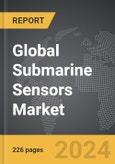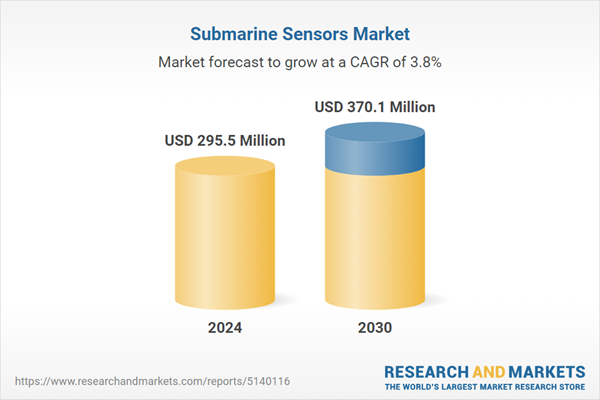The global market for Submarine Sensors was valued at US$295.5 Million in 2024 and is projected to reach US$370.1 Million by 2030, growing at a CAGR of 3.8% from 2024 to 2030. This comprehensive report provides an in-depth analysis of market trends, drivers, and forecasts, helping you make informed business decisions. The report includes the most recent global tariff developments and how they impact the Submarine Sensors market.
Segments: End-Use (SSN-Nuclear Attack Submarine Sensors, SSK-Diesel Electric Submarine Sensors, SSBN-Ballistic Missile Submarine Sensors).
Geographic Regions/Countries: World; United States; Canada; Japan; China; Europe (France; Germany; Italy; United Kingdom; Spain; Russia; and Rest of Europe); Asia-Pacific (Australia; India; South Korea; and Rest of Asia-Pacific); Latin America (Argentina; Brazil; Mexico; and Rest of Latin America); Middle East (Iran; Israel; Saudi Arabia; United Arab Emirates; and Rest of Middle East); and Africa.
The analysts continuously track trade developments worldwide, drawing insights from leading global economists and over 200 industry and policy institutions, including think tanks, trade organizations, and national economic advisory bodies. This intelligence is integrated into forecasting models to provide timely, data-driven analysis of emerging risks and opportunities.
Global Submarine Sensors Market - Key Trends and Drivers Summarized
Why Are Submarine Sensors Vital for Modern Naval Operations?
Submarine sensors are essential for a wide range of submarine activities, from navigation and communication to surveillance and threat detection. These sensors include sonar systems, electromagnetic sensors, radar, and infrared detection systems that enable submarines to perform silent and undetected operations while gathering critical intelligence. In modern naval operations, sensors are pivotal for ensuring situational awareness, tracking adversary vessels, and detecting underwater mines or threats in real time. With global maritime security challenges rising, the demand for advanced submarine sensors is increasing rapidly across naval forces worldwide.How Are Technological Advancements Driving Innovation in Submarine Sensors?
Technological advancements are revolutionizing submarine sensors, particularly in sonar and acoustic technologies. Modern sonar systems have improved in terms of range, precision, and noise reduction, allowing submarines to detect and classify objects with better accuracy. Electromagnetic sensors are also being developed for more effective detection of submarines, mines, and other underwater objects. Integration of artificial intelligence (AI) and machine learning (ML) into sensor systems is further enhancing real-time data processing and threat analysis. Additionally, the use of fiber-optic sensors in sonar arrays is improving performance by reducing signal interference, and innovations in sensor miniaturization are making systems more efficient for smaller or autonomous underwater vehicles.Which Segments Are Leading the Adoption of Submarine Sensors?
The submarine sensors market is divided into various technology segments, including sonar systems, electromagnetic sensors, and optical sensors, with sonar systems accounting for the largest market share. Sonar systems, both active and passive, are critical for submarine navigation and detection capabilities, particularly in deep-sea and littoral environments. Electromagnetic sensors are increasingly being used for underwater surveillance, including the detection of stealth submarines and mines. End-users of submarine sensors are primarily military naval forces, though scientific research institutions and commercial deep-sea exploration companies also utilize these technologies. Geographically, North America, Europe, and Asia-Pacific lead the adoption of advanced submarine sensor systems, driven by defense spending and maritime security initiatives.What Is Driving the Growth of the Submarine Sensor Market?
The growth in the submarine sensor market is driven by several factors, including increasing investments in naval defense, advancements in sonar and electromagnetic detection technologies, and the rising threat of underwater drones and stealth submarines. The growing need for enhanced situational awareness and real-time data processing is pushing the demand for AI-integrated sensor systems. Moreover, increased defense budgets, particularly in the U.S., China, and Russia, are propelling the adoption of next-generation sensor technologies. Innovations in fiber-optic and AI-based sensor systems are expanding the capabilities of submarines, making them more effective in detecting and neutralizing threats, thus driving growth in this market.Report Scope
The report analyzes the Submarine Sensors market, presented in terms of units. The analysis covers the key segments and geographic regions outlined below.Segments: End-Use (SSN-Nuclear Attack Submarine Sensors, SSK-Diesel Electric Submarine Sensors, SSBN-Ballistic Missile Submarine Sensors).
Geographic Regions/Countries: World; United States; Canada; Japan; China; Europe (France; Germany; Italy; United Kingdom; Spain; Russia; and Rest of Europe); Asia-Pacific (Australia; India; South Korea; and Rest of Asia-Pacific); Latin America (Argentina; Brazil; Mexico; and Rest of Latin America); Middle East (Iran; Israel; Saudi Arabia; United Arab Emirates; and Rest of Middle East); and Africa.
Key Insights:
- Market Growth: Understand the significant growth trajectory of the SSN-Nuclear Attack Submarine Sensors segment, which is expected to reach US$173.0 Million by 2030 with a CAGR of a 3.7%. The SSK-Diesel Electric Submarine Sensors segment is also set to grow at 3.8% CAGR over the analysis period.
- Regional Analysis: Gain insights into the U.S. market, valued at $79.2 Million in 2024, and China, forecasted to grow at an impressive 6.1% CAGR to reach $75.5 Million by 2030. Discover growth trends in other key regions, including Japan, Canada, Germany, and the Asia-Pacific.
Why You Should Buy This Report:
- Detailed Market Analysis: Access a thorough analysis of the Global Submarine Sensors Market, covering all major geographic regions and market segments.
- Competitive Insights: Get an overview of the competitive landscape, including the market presence of major players across different geographies.
- Future Trends and Drivers: Understand the key trends and drivers shaping the future of the Global Submarine Sensors Market.
- Actionable Insights: Benefit from actionable insights that can help you identify new revenue opportunities and make strategic business decisions.
Key Questions Answered:
- How is the Global Submarine Sensors Market expected to evolve by 2030?
- What are the main drivers and restraints affecting the market?
- Which market segments will grow the most over the forecast period?
- How will market shares for different regions and segments change by 2030?
- Who are the leading players in the market, and what are their prospects?
Report Features:
- Comprehensive Market Data: Independent analysis of annual sales and market forecasts in US$ Million from 2024 to 2030.
- In-Depth Regional Analysis: Detailed insights into key markets, including the U.S., China, Japan, Canada, Europe, Asia-Pacific, Latin America, Middle East, and Africa.
- Company Profiles: Coverage of players such as Atlas Elektronik GmbH, DRS Technologies, Inc., Ducommun, Inc., Harris Corporation, L3 KEO and more.
- Complimentary Updates: Receive free report updates for one year to keep you informed of the latest market developments.
Some of the 48 companies featured in this Submarine Sensors market report include:
- Atlas Elektronik GmbH
- DRS Technologies, Inc.
- Ducommun, Inc.
- Harris Corporation
- L3 KEO
- Lockheed Martin Corporation
- Northrop Grumman Corporation
- Raytheon Company
- Safran Electronics & Defense
- Thales Group
Tariff Impact Analysis: Key Insights for 2025
Global tariff negotiations across 180+ countries are reshaping supply chains, costs, and competitiveness. This report reflects the latest developments as of April 2025 and incorporates forward-looking insights into the market outlook.The analysts continuously track trade developments worldwide, drawing insights from leading global economists and over 200 industry and policy institutions, including think tanks, trade organizations, and national economic advisory bodies. This intelligence is integrated into forecasting models to provide timely, data-driven analysis of emerging risks and opportunities.
What’s Included in This Edition:
- Tariff-adjusted market forecasts by region and segment
- Analysis of cost and supply chain implications by sourcing and trade exposure
- Strategic insights into geographic shifts
Buyers receive a free July 2025 update with:
- Finalized tariff impacts and new trade agreement effects
- Updated projections reflecting global sourcing and cost shifts
- Expanded country-specific coverage across the industry
Table of Contents
I. METHODOLOGYII. EXECUTIVE SUMMARY2. FOCUS ON SELECT PLAYERSIII. MARKET ANALYSISSOUTH KOREAREST OF ASIA-PACIFICARGENTINABRAZILMEXICOREST OF LATIN AMERICAIRANISRAELSAUDI ARABIAUNITED ARAB EMIRATESREST OF MIDDLE EASTIV. COMPETITION
1. MARKET OVERVIEW
3. MARKET TRENDS & DRIVERS
4. GLOBAL MARKET PERSPECTIVE
UNITED STATES
CANADA
JAPAN
CHINA
EUROPE
FRANCE
GERMANY
ITALY
UNITED KINGDOM
SPAIN
RUSSIA
REST OF EUROPE
ASIA-PACIFIC
AUSTRALIA
INDIA
LATIN AMERICA
MIDDLE EAST
AFRICA
Companies Mentioned (Partial List)
A selection of companies mentioned in this report includes, but is not limited to:
- Atlas Elektronik GmbH
- DRS Technologies, Inc.
- Ducommun, Inc.
- Harris Corporation
- L3 KEO
- Lockheed Martin Corporation
- Northrop Grumman Corporation
- Raytheon Company
- Safran Electronics & Defense
- Thales Group
Table Information
| Report Attribute | Details |
|---|---|
| No. of Pages | 226 |
| Published | April 2025 |
| Forecast Period | 2024 - 2030 |
| Estimated Market Value ( USD | $ 295.5 Million |
| Forecasted Market Value ( USD | $ 370.1 Million |
| Compound Annual Growth Rate | 3.8% |
| Regions Covered | Global |









